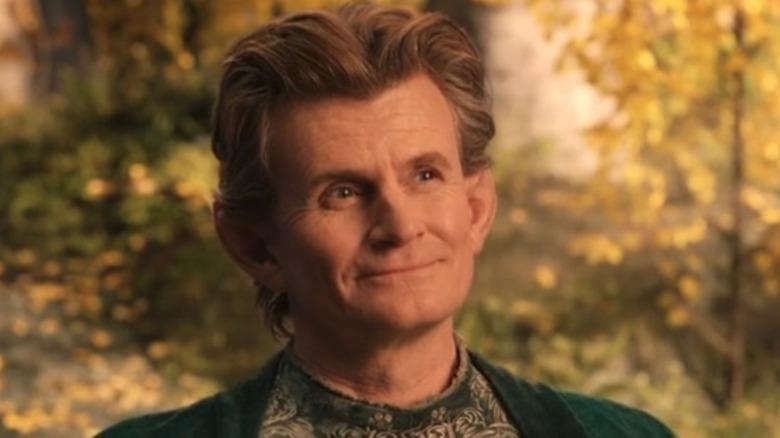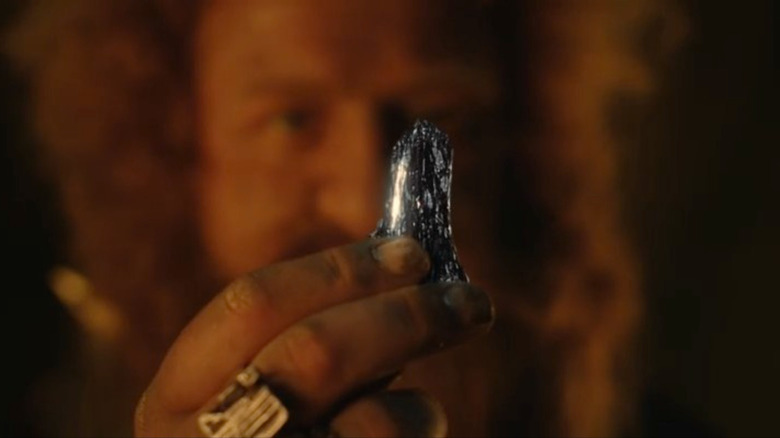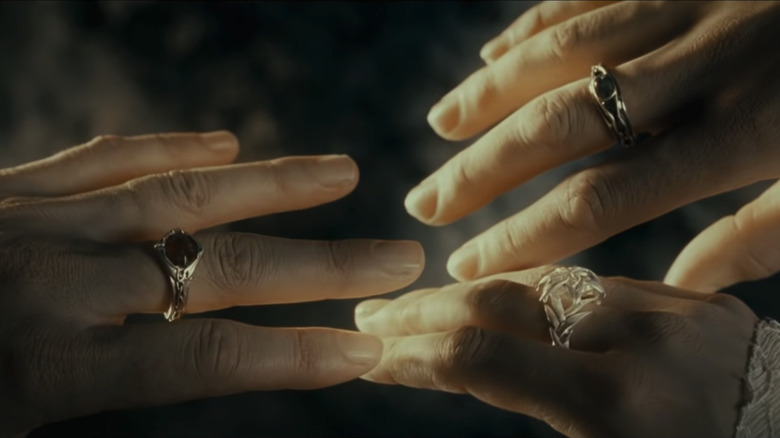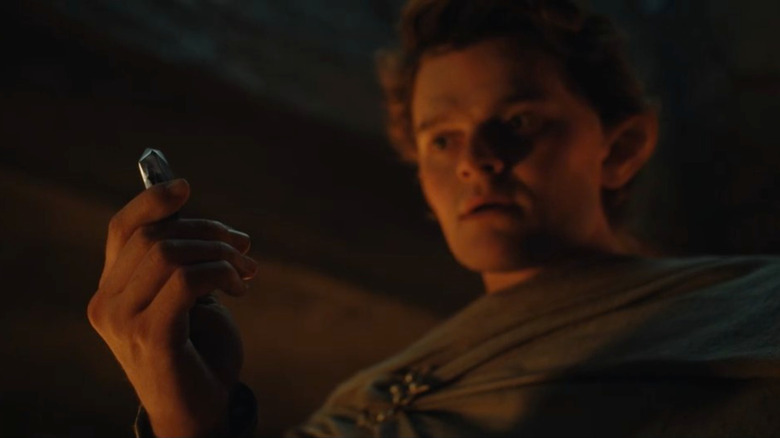The Rings Of Power Season 1 Is Building Toward A Fascinating Reveal About Its Titular Jewelry
Contains spoilers for "The Rings of Power" through Episode 5
"The Lord of the Rings: The Rings of Power" will have some dynamic circular jewelry in it at some point. It has to. For goodness sake, it's in the title ... twice. The question is, why haven't we seen anything along those lines yet?
Tolkien heads are well aware of the answer to that question. By the time of "The Hobbit" and "The Lord of the Rings," Sauron is already searching for the One Ring. The Nazgûl are warped by their own jewelry. The Dwarven Rings have been lost in translation. The Elves are warily and secretly using their Three Rings. All of that stuff is already in motion.
During "The Rings of Power" story, though, well, that's when the titular Rings of Power are forged in the first place. The Second Age of Tolkien's world is defined by several major events, but none of them shine as brightly as the forging of the Rings of Power, culminating in the creation of the One Ring to rule them all.
The curious case of miraculous mithril
A solid portion of the fifth episode of "The Rings of Power" takes place in Lindon. The Elvish realm is led by the High King Gil-galad, who is joined by his herald, Elrond, as well as Prince Durin IV of Khazad-dûm and Celebrimbor, Lord of Eregion. Over the course of the episode, it comes out that the Elves are seriously interested in the Dwarves' discovery of Mithril because they want to use it to replenish their light. No, literally. They want to heat vast quantities of it up in a giant furnace to somehow bathe in its light and reinvigorate their immortal souls.
Elrond even shares an apocryphal story in which an Elf and Balrog duel over a tree with a Silmaril hidden inside it. When lightning strikes the tree, it serves as the catalyst to create mithril through the plant's mountainous roots. This wild origin story of the miracle metal highlights the stakes for the Elves in the first season of the show. They need to get some of that sweet, sweet Valinorian light, otherwise they'll have to abandon Middle-earth entirely.
The connection between mithril and the light of the Silmarils is made up for the show. The closest thing we find in Tolkien's writings about the importance of mithril is in the appendices to "The Return of the King," where it says that some of the Elves settle in Eregion "because they learned that mithril had been discovered in Moria." However, it connects this interest in the precious metal to craftsmanship, not the light of the Two Trees. Nevertheless, the desire for longevity and preservation does have an interesting connection to something else that plays a key role in "The Rings of Power" story — the actual Rings of Power.
Three Rings for the Elven-kings
In the original story penned by Tolkien himself, Celebrimbor and his, er, friend (hint: it's Sauron in disguise!) join forces to create the Rings of Power. Initially, they make sixteen of these, which become the Seven for the Dwarf-lords and the Nine for Mortal Men. After that, Sauron forges the One Ring to rule them all, but not before Celebrimbor makes three ultra-powerful rings all on his lonesome. These become the Three Rings for the Elven-kings. Even though the One Ring can dominate them, they don't have the same corrupting power as the ones that Sauron actually helped to make, which is an important point.
At the Council of Elrond in "The Fellowship of the Ring" book, Elrond explains that, "The Three were not made by Sauron, nor did he ever touch them." Later he adds that, while they're still being used for good, "they were not made as weapons of war or conquest: that is not their power. Those who made them did not desire strength or domination or hoarded wealth, but understanding, making, and healing, to preserve all things unstained." The Half-elven counselor adds the sad line, "These things the Elves of Middle-earth have in some measure gained, though with sorrow."
This is just the tip of the iceberg, too. Tolkien had a lot more to say when it came to the purpose of the Three Rings and how they factored into the Elvish mindset — especially for those who had spent time in the Blessed Realm away in the West.
Preserving unchanging beauty
The idea that the Three Rings of the Elves are uniquely suited to protect, heal, and restore is found ad-nauseam in Tolkien's writings. "The Silmarillion" explains that, when it came to the Three Rings of the Elves, "of all the Elven-rings Sauron most desired to possess them, for those who had them in their keeping could ward off the decays of time and postpone the weariness of the world."
In a letter Tolkien wrote in 1954, he went into even more detail, explaining that of the Elves, "Those who lingered were those who were enamoured of Middle-earth and yet desired the unchanging beauty of the Land of the Valar. Hence the making of the Rings; for the Three Rings were precisely endowed with the power of preservation, not of birth." In another letter written in Tolkien wrote to his publisher in 1951, the author explained the concept again, saying, "The chief power (of all the rings alike) was the prevention or slowing of decay (i.e. 'change' viewed as a regrettable thing), the preservation of what id desired or loved, or its semblance — this is more or less an Elvish motive."
See the connection there? The Three Rings are ultimately made to preserve what the Elves already had — which is precisely what they're trying to do with mithril in Season 1 of "The Rings of Power." So, while the whole "mithril is imbued with the light of the Two Trees via a lightning-struck Silmaril" storyline doesn't have a direct connection to the source material, it looks an awful lot like the writers are setting the stage for the Elves to try making some powerful rings, you know, if the whole mithril thing is a nonstarter.



